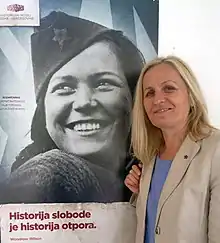Štefica Galić
Štefica Galić (born 16 March 1963) is a Bosnian journalist and human rights activist. During the Bosnian War, Galić saved about a thousand people from internment in a detention camp. She is a vocal critic of nationalist politics. Since September 2019, Štefica Galić has been protected by the German Bundestag.[1]

Wartime activities
Štefica Galić is an ethnic Croat from the Herzegovinian town of Ljubuški, in southern Bosnia-Herzegovina.[2] In 1992, the Croat–Bosniak War broke out, part of the larger Bosnian War. The Bosniaks of Ljubuški were rounded up by Croat militia on 15 August 1993.[2] Štefica Galić and her husband, photographer Nedeljko Galić, worked to prevent the deportation of the Bosniaks of Ljubuški to the detention camps of Dretelj, Gabela, and Heliodrom.[2][3] The Galićs falsified affidavits for the people interned in the camps to prove they had a relation outside of Bosnia they could move to rather than stay at the camps.[2] According to the testimonies gathered by the Gardens of the Righteous Worldwide organization, the couple rescued about a thousand people from the camp, two thirds of the total Bosniak population of Ljubuški.[2][3]
Repulsed by the treatment of their fellow denizens, the Galićs moved with their three children to Prague, Czech Republic, in late 1993. They refused the benefits accorded to refugees, insisting that they were not the expelled ones. Homesickness forced them to return to Ljubuški a year later, where they were stigmatized as Yugonostalgics and "Commies".[2] Supporters have praised Štefica Galić as the "Schindler of Ljubuški".[2] In 2019, Galić published an article about the murder of civilians in Ljubuški in 1993.[4]
Journalism
After her husband's death in 2001, Galić became a journalist.[2] Following the airing of a film about the rescue of the Bosniaks of Ljubuški in July 2012, Galić was physically assaulted by a war veterans' association activist.[2][3] The attack was condemned by the United States, European Union, and OSCE representatives.[2] Posters placed around the town branded them "enemies of the Croatian people".[3] Two years later, Galić left Ljubuški and moved to Mostar, where she also receives threats.[5]
Since 2010, Galić has been the editor-in-chief of the independent news website site tacno.net, which opposes ethnic nationalism in Bosnia-Herzegovina and features authors from other former Yugoslav republics as well. Galić has stated that she is inspired by Feral Tribune and BH Dani. She acknowledges the discrimination against women in journalism, but says that the nationalism-inspired assaults on her have made her oblivious to it.[5]
In 2017, Galić signed the Declaration on the Common Language of the Croats, Serbs, Bosniaks and Montenegrins.[6]
Galić won the International Johann Philipp Palm Award for Freedom of Speech and the Press 2018.[7][8]
References
- Šabić, Adin (11 September 2019). "Member of the Bundestag, Manuel Sarrazin: Štefica Galić can count on our protection". Mostar: Tačno.net. Retrieved 12 September 2019.
- Pavelić, Boris (9 August 2012). "Dangerous Life of Stefica Galic, Ljubuski's Oskar Schindler". Balkan Insight. Retrieved 15 August 2018.
- Orentlicher, Diane (30 March 2018). Some Kind of Justice: The ICTY's Impact in Bosnia and Serbia. New York, NY: Oxford University Press. ISBN 978-0-19-088228-0. Retrieved 15 August 2018.
- Galić, Štefica (11 September 2019). "Ko ih je ubio?" [Who killed them?] (in Serbo-Croatian). Mostar: Tačno.net. Retrieved 12 September 2019.
- Durkalić, Masha (2 November 2017). "Štefica Galić" (in Serbo-Croatian). Balkan Insight. Retrieved 15 August 2018.
- Signatories of the Declaration on the Common Language, official website, retrieved on 2017-08-16.
- "Štefica Galić dobitnica nagrade Johan Philipp Palm" (in Serbo-Croatian). N1. 26 June 2018. Retrieved 26 June 2018.
- "Štefica Galić's speech at the award ceremony: There is no price tag to relinquish determination and morality, in short – to be human". Mostar: Tačno.net. 5 December 2018. Retrieved 22 December 2018.